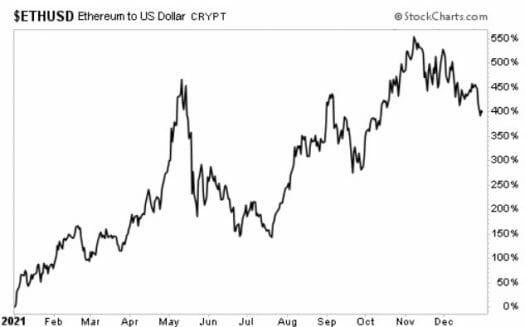Dipping Our Toes Into Crypto… The Mysterious Origins Of Bitcoin… And Understanding The Basics
Back in January, I wrote a little note asking readers about their interest in cryptocurrencies.
As I mentioned, we’ve dabbled in these waters before. Whether it’s explaining some of the basics, weighing in on the latest controversies, or wild price action, we’re not allergic to talking about it.
There’s a lot to like, in theory, about the promise of crypto. But between the wild volatility and understanding some of the technical aspects and lingo, it can seem a little daunting at times.
That’s where we want to step in.
As it turns out, some of you have already dabbled in this world – or are at least open to learning more.
And that’s why I’m proud to announce that my colleague Jimmy Butts will be picking up the torch and walking his premium readers through the ins and outs of cryptocurrency.
Keep in mind, Jimmy isn’t going to deviate from his primary mission of providing actionable ideas in the world of equities. But as he put it to me, the goal will be to occasionally weigh in on this new asset class, providing basic education and ideas for those who are interested. That’s it, really.
Remember my note in January… I pointed out that one of the big investing predictions we made in 2021 was about Ethereum. In fact, back then, we said “if you’re going to invest in one cryptocurrency, this should be it”.
ETH went on to gain about 400% after we wrote about it in 2021.

The point is, there’s too much potential here – and too much reader interest – to not talk about it at least a little bit.
As we’ve said before, we think this new frontier of money is going to continue presenting incredible opportunities for investors in 2022 — and beyond. And as a matter of fact, we have another big cryptocurrency prediction in this year’s Predictions report.
But this new asset class doesn’t come without risks… And it will require more innovation – as well as a wider understanding among the general public – before it can reach its potential.
So stay tuned, because we’re going to be introducing readers to the world of cryptocurrency more in the weeks to come…
In the meantime, I’m going to hand things off to Jimmy, who recently wrote in his premium newsletter about the origins of bitcoin and its mysterious creator. Regardless of whether you’re interested in investing yourself, you’ll come away from reading this with a better understanding of bitcoin and cryptocurrency in general.
Regards,
Brad Briggs
StreetAuthority Insider
The Mysterious Origins Of Bitcoin — And Understanding The Basics
 In August 2008, someone anonymously registered the bitcoin.org domain name. That was the first known appearance of the word “bitcoin.”
In August 2008, someone anonymously registered the bitcoin.org domain name. That was the first known appearance of the word “bitcoin.”
Then, in October 2008, a coder going by the name of Satoshi Nakamoto published a white paper describing the basics of bitcoin. He is said to have been writing the computer code for a year and a half.
In January 2009, the world’s first cryptocurrency — bitcoin — was born.

Bitcoin is purely digital. It’s just zeros and ones (known as “bits”) on a computer network… hence the name “bit”-coin.
Being purely digital isn’t as radical a departure from today’s currency as it sounds. In fact, it’s estimated that 92% of the world’s currency is digital. In other words, only about 8% of fiat currency is physical money.
Think about the U.S. dollar… When you swipe your card to purchase groceries, or even write a check, no physical bills exchange hands. The value exchange (money for goods) happens behind the scenes on a network with your bank communicating with a merchant provider who then communicates with another financial institution. And then everybody hopes to collect as some point.
Think about how convoluted this is, and how easily it can be (and is) defrauded. We’ve all probably had a check “bounce” — whether it was one we wrote or one that we were cashing.
If we pay with a credit card, there’s no verification that those goods will actually get paid for by the card holder. Sure, the store still gets its money and doesn’t care, but now the financial institution that issued the credit card must collect the funds.
Bitcoin — and cryptocurrencies — solve a lot of these problems.
Bitcoin exists entirely outside of the traditional banking system. It doesn’t rely on banks to manage accounts or verify transactions. As a result, there are no middlemen, such as JPMorgan Chase or Visa.
Bitcoin is transferred via a peer-to-peer network, which doesn’t have a central computer server or authority. Unlike dollars, bitcoins aren’t a central bank’s liability (or “IOU”) — a characteristic it shares with gold, which means it isn’t a liability of the central bank either.
But bitcoin is much easier to transfer than gold…
Another characteristic it shares with gold is that there is a limited supply. Gold is scarce. Miners continue to extract more, but the total supply is limited by nature. The Earth’s crust only holds so much gold.
Bitcoin’s supply is limited by computer code. Ultimately, there will be 21 million bitcoins. No more, no less.
Bitcoin is also fungible: one bitcoin is equivalent to any other.
This eliminates the need for currency conversions. We don’t have to worry about how the U.S. dollar stacks up to the euro or the peso when traveling or when companies purchase product from overseas.
This standardization makes it so we can easily measure the value of goods and services. And although bitcoin is far from universal, the attributes of bitcoin make it a good medium of exchange.
More and more businesses and even countries are recognizing bitcoin as a legal payment method and currency. In April 2017, the Japanese government officially recognized bitcoin as legal tender, and just last year (2021) El Salvador adopted bitcoin as a recognizable form of payment.
Overstock.com accepts bitcoin, as does Microsoft’s Windows and Xbox online services. You can even pay for DISH Network’s satellite television service with bitcoin.
Granted, currently, bitcoin is not an ideal medium of exchange because its price is so volatile. But over time, if bitcoin’s volatility moderates and more merchants accept it as payment, it will better serve as a medium of exchange.
Editor’s Note: I just released another BIG prediction about cryptocurrencies in my annual list of predictions for 2022…
Last year, we told investors we were bullish on Ethereum — and it went on to deliver 400% gains. My team and I predict cryptocurrencies will surge again in 2022… but the big winner won’t be Bitcoin, Binance, or Ethereum. We think another crypto is now a better bet for new investors. It is 321 times faster than its prime competitor and we think it could surpass it in value…
Learn more about this new crypto and the rest of my predictions now.
